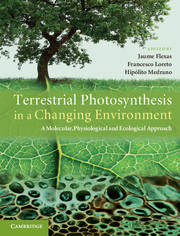 Terrestrial Photosynthesis in a Changing Environment
Terrestrial Photosynthesis in a Changing Environment Published online by Cambridge University Press: 05 March 2013
Introduction
Photosynthesis studies and models are usually restricted to green leaves. However, a closer observation of nature reveals that most plants also photosynthesise through non-foliar structures, and photosynthetic tissues are not always green. Non-foliar photosynthesis is performed by a variety of organs such as stems, bark, roots, petioles, fruits or flowers. These structures contribute positively to the carbon balance, and in some leafless species these are the only photosynthetic organs. In general, two main groups of photosynthetically active organs can be discerned (Aschan and Pfanz, 2003): those optimised for photosynthetic performance that achieve a net positive carbon gain (such as green petals, leaves or stems); and those involved in the internal recycling of CO2 released by respiration (such as roots, fruits or chlorophyll-containing bark) (Table 7.1). With a few exceptions, chlorophyll is the only green pigment in plants, implying that all green tissues are chlorophyllous, and all chlorophyll-containing organs are, to some extent, photosynthetic. Nevertheless, photosynthetic organs may not appear green externally because of chlorophyll being masked by outer layers of pigmented cells, waxy cuticles or bark. In addition to plants with whole leaves or parts of leaves (variegated leaves) presenting special photosynthetic characteristics, unique photosynthetic adaptations are also shown by parasitic and submerged plants. Also, stomatal cells from typical leaves of higher plants display specific photosynthetic features, different from those of mesophyll cells.
To save this book to your Kindle, first ensure [email protected] is added to your Approved Personal Document E-mail List under your Personal Document Settings on the Manage Your Content and Devices page of your Amazon account. Then enter the ‘name’ part of your Kindle email address below. Find out more about saving to your Kindle.
Note you can select to save to either the @free.kindle.com or @kindle.com variations. ‘@free.kindle.com’ emails are free but can only be saved to your device when it is connected to wi-fi. ‘@kindle.com’ emails can be delivered even when you are not connected to wi-fi, but note that service fees apply.
Find out more about the Kindle Personal Document Service.
To save content items to your account, please confirm that you agree to abide by our usage policies. If this is the first time you use this feature, you will be asked to authorise Cambridge Core to connect with your account. Find out more about saving content to Dropbox.
To save content items to your account, please confirm that you agree to abide by our usage policies. If this is the first time you use this feature, you will be asked to authorise Cambridge Core to connect with your account. Find out more about saving content to Google Drive.